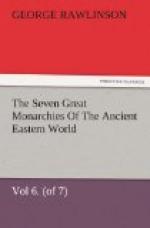Underneath these quasi-capitals, at the distance of from two to three feet, ran a cornice, which crossed the pilasters, and extended the whole length of the apartment, consisting of flowers and half-ovals, each oval containing a half-ball of the same dark stone as the capitals. [PLATE IV. Fig. 4.] Finally, on the pilasters, immediately below the cornice, were sculptured commonly either two or three human heads, the length of each head being about two feet, and the faces representing diverse types of humanity, some old and some young, some male and some female, some apparently realistic, some idealized and more or less grotesque in their accompaniments. The drawing of the heads is said to have been full of spirit, and their general effect is pronounced life-like and striking.
The seven halls, which have been described, were divided into two groups, of three and four respectively, by a low fence, which ran from east to west across the inner court, from the partition wall separating the third and fourth halls to the buildings which divided the inner court from the outer. It is probable that this division separated the male and female apartments. The female ornamentation of the large hall (No. II.) belonging to the southern group is perhaps an indication of the sex of its inmates; and another sign that these were the female quarters is to be found in the direct communication existing between this portion of the building and “the Temple” (No. VIII.), which could not be reached from the male apartments except by a long circuit round the building.
The “Temple” itself was an apartment of a square shape, each side being about forty feet. It was completely surrounded by a vaulted passage, into which light came from two windows at its south-west and north-west corners. The Temple was entered by a single doorway, the position of which was directly opposite an opening leading into the passage from Hall No. II. Above this doorway was a magnificent frieze, the character of which is thought to indicate the religious purpose of the structure. [PLATE V. Fig. 1.] The interior of the Temple was without ornamentation, vaulted, and except for the feeble light which entered by the single doorway, dark. On the west side a portal led into the passage from the outer air.
[Illustration: PLATE 5.]
Besides these main apartments, the edifice which we are describing contained a certain number of small rooms, lying behind the halls, and entered by doorways opening from them. One or two such rooms are found behind each of the smaller halls; and another of somewhat larger dimensions lay behind the great hall (numbered VII. in the plan), forming the extreme north-western corner of the building. These rooms were vaulted and had no windows, receiving their only light from the small doorways by which they were entered.




